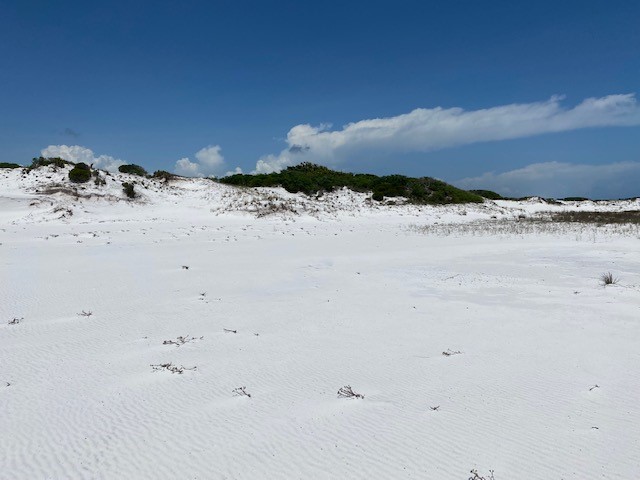
by Rick O'Connor | May 13, 2022
It is mid-spring and time of nesting for much of the wildlife in the area. It is also noticeably warmer than our previous hikes. Due to my work schedule, and the surveys for other nesting activity, I did this hike earlier in the month and later in the day, than I typically would have. I began my hike at 1:00pm – near the hottest part of the day, and not the best time to see wildlife, but I definitely wanted to get a hike in this month and so this is when I could.
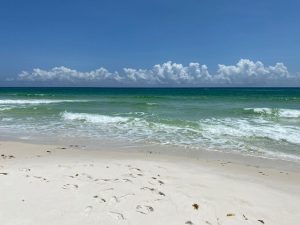
The Gulf was relatively calm on this early afternoon in spring.
It was warm. On this day it was 83°F and there was a light breeze from the southeast. On the previous hikes I needed my fleece. Though I had it in my backpack, I did not need it today. My hike was at Big Sabine and as usual, I began on the Gulf of Mexico. The first thing I noticed when I crossed over the boardwalk was the number of people. I usually hike in the early morning or late afternoon and see few humans. But at mid-day the beach was full of people, and I probably looked strange walking among them with my long pants, long sleeved shirt, and boots. The second thing I noticed was mats of Sargassum on the beach.
Sargassum is a floating brown algae we see in the warmer months in our part of the Gulf. It is first an algae, not a true plant. Algae lack roots, stems, and leaves. They produce no cones, fruit nor flowers with seeds. They are nonvascular, meaning they lack a system of vein-like tubes that move water around the plant. Plants usually do have these tubes. They are not called arteries and veins as they are in animals, but rather xylem and phloem. Because algae lack this circulation system, they live emersed in the water. Since they lack true roots they anchor to hard substrate, like rocks and coral, using a suction type apparatus called a holdfast. The flexible, herbaceous stipe, analogous to the stem, flows in the current extending their blades (analogous to leaves) into the light. Like plants, algae require water, carbon dioxide, and sunlight to photosynthesize their food. Because of this they need to live in relatively shallow water, and they need a rocky bottom to attach their holdfast to. We have little hard bottom and therefore less of the classic algae you read about in other parts of the world.
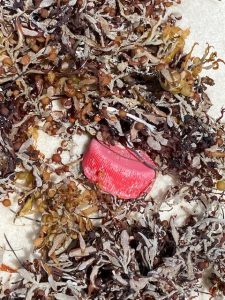
Notice the small air bladders on this Sargassum weed. These are used by the algae to remain near the sunlit waters of the open Gulf.
Sargassum has a different plan to deal with this problem. They float. When you look at this seaweed on the beach you will notice they have numerous small circular air bladders called pneumatophores. These air bladders allow Sargassum to float in the sunlit waters of the Gulf and not worry about how, or where, they would attach their holdfast.
Large mats of Sargassum can be found floating out in the open Gulf and these mats provide a fantastic habitat for many small and large marine creatures. There are sargassum crabs, sargassum shrimp, and even a sargassum sea horse. There is a small filefish and a frogfish known as the sargassum fish. It is the target for baby sea turtles that successfully made it from the beach, through the surf, and into the open Gulf without being consumed. Here they will live and feed for many months at which time they are large enough to venture back out. Larger fish often seek out these mats searching for food, and fishermen seek the mats knowing that larger fish are probably in the area.
These mats of Sargassum get caught in the large ocean currents and find their way to the middle of the Atlantic. Here the ocean is calm, like the eye of a hurricane, and huge mats of Sargassum can be found piled up. Christopher Columbus found this massive expanse of Sargassum while crossing the Atlantic. Because it was calm here, and the Sargassum so thick, his ships became becalmed and he noted in his log to avoid this place, which was then called the “Sargasso Sea”.
On today’s hike there was quite a bit of this seaweed washed ashore. Most of the marine life living in the seaweed sense the waves and the impending beaching, and jettison for mats further offshore. So, you usually do not find many creatures in the seaweed washed ashore, but sometimes you do. You can take a small dip net out deeper and grab some still floating and you may have better luck. Today, I explored what was washed ashore and did not find much. I did find a lot of plastic, and those who study Sargassum ecology will tell there is a lot of plastic debris caught up in the Sargassum mats. Today I noticed a lot of bottle caps. Not many bottles, but lots of bottle caps. As many others do, we encourage everyone to dispose of the garbage properly. I read this week of a manatee found near Mobile Bay earlier this year who died of cold stress but had swallowed a plastic bag, which was caught in his throat. Marine debris kills. Please dispose of your trash properly.
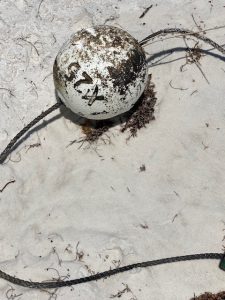
This crab pot float was one of several debris items washed in with the sargassum.
Heading inland to the dune field I heard sirens. The beach patrol was answering a call. I am not sure where, nor what the issue was, but these again are sounds I do not usually hear when hiking early and late in the day. There are currents in the Gulf that can suck you out to sea, and each year we have visitors drown not knowing where these currents are, or how to get out of them if they are caught in one. Pay attention to the colored flags and be careful. I never saw, nor heard, an ambulance follow the beach patrol. So, I am guessing everyone was okay on this call.
The dune field on this May afternoon was warm. There was a light breeze from the southeast that kept things from getting too warm, but it was warm none the less. As we move closer the hot days of summer the wildlife will move more at dawn and dusk, as well as in the evening. I was not expecting to see a lot on this hike.
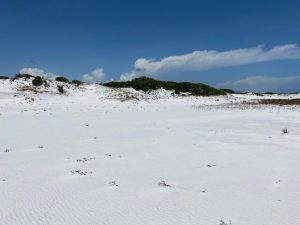
This flat area of the dune field was quite warm on this afternoon and made me think of crossing a desert.
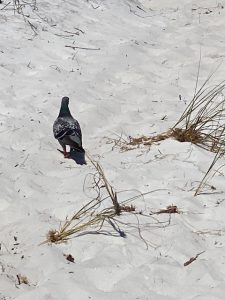
This was an unusual site, a pigeon walking in the open dune field.
As always you can see what has been moving by searching for tracks and tracks, I did find. Many of them were human, indicating the tourist season is upon us, but there were tracks of animals as well. There were plenty from our friends the raccoon and armadillo. I did notice more raccoon tracks this month. I and my volunteers who survey nesting beaches notice more raccoon tracks this time of year looking for eggs. I also noticed more snake tracks on this hike, they too are mating and moving much more. The lizard tracks were fresh, and I have noticed these moving during the warmer parts of the day and their tracks running across the dune face told me they were very busy that day.
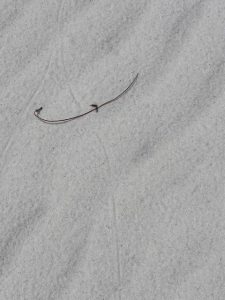
This straight line the sign of a tail drag by a lizard, most likely the six-lined skink.
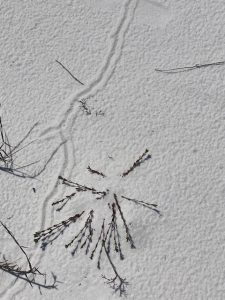
Many who visit the dunes of our barriers find these burrow looking trails. These are made by beetles.
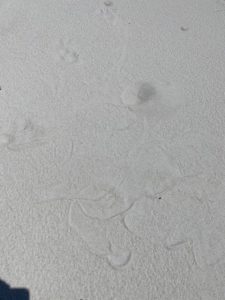
I followed this snake track until I found this – what appears to be a “tussle” the snake had with a possible prey.
Being spring you would expect flowers, and there were some, just not as many as you might expect. Most of them were white and were blooming on plants near the boggy areas of the swales. The conradina that blooms more in the winter, was done and the blossoms were gone. I did see the early stages of the magnolia flowers trying to come up, but the bright green shoots of new growth on the pines were not visible. There were bees, lots of bees.
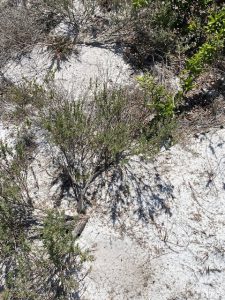
The lavender blossoms of the false rosemary, which appeared in winter, are now gone.
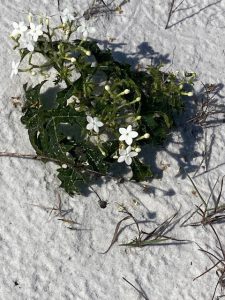
White flowers were common on this spring afternoon. Such as this one on the spiny bull nettle.
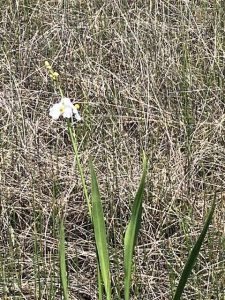
Another white flower is seen on this Sagittaria growing in one of the swales between dunes.
I hiked through a small pine scrub area thinking I might someone in the shade avoiding the heat of the day but did not find anything. I went along the edge of the tertiary dunes where they meet the maritime forest looking for the same thing. Nothing, but there were tracks. The cactus seemed to be more abundant this month.
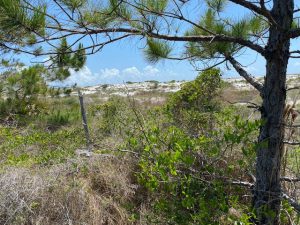
The pine scrub offered one of the few places with shade.
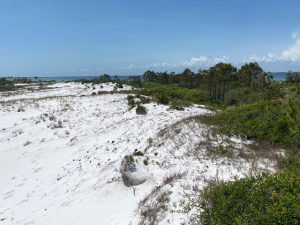
The dune field of a Florida panhandle barrier island.
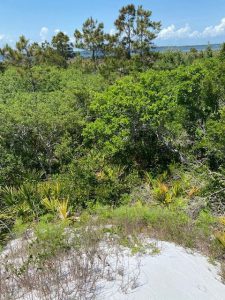
From atop of one of the higher dunes you can see the steep drop towards the marsh.
Along the ridge between the maritime forest and the salt marsh is where I found the otter slide last month. I did not see any evidence of otters today. The bird action was slower today as well. Maybe because of the heat they too had settled somewhere. I did not see an osprey, which is unusual.
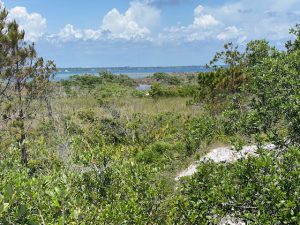
Big Sabine as seen from atop one of the larger dunes.
As I reached the beach of the Sound, I did notice a LOT of digging by armadillos. They had been very active. There were no snakes or marsh rats. There were again people, these were on jet skis. There were a few fishing from small boats. With no rain over the last week or so the visibility in the Sound was amazing, but I only saw one small blue crab. No hermit crabs and not any fish. However, the lagoon of the marsh the killifish, also known as bull minnows, were abundant and the males all aglow with their iridescent blue colors of breeding season. The males were chasing each other all over the tidal pools and open water of the lagoon designating their territories for current breeding that would follow. I did notice more crows than I usually do and what made me catch their attention was the constant calling at me and the hovering over me suggesting they too were breeding, and an active nest was nearby.
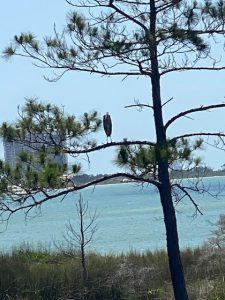
A blue heron is seen sitting in a pine overlooking Santa Rosa Sound.
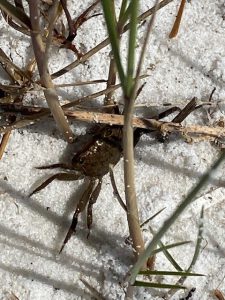
A small Seserma crab is seen hiding under grass along the beach of the Sound.
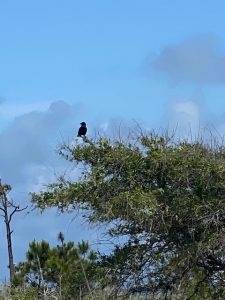
The crows were numerous and active on this spring afternoon.
I was not expecting much hiking in the middle of the afternoon, but it is always good to do these just to see what is moving. I hope to do another hike this month either early in the morning or late in the afternoon. Maybe we will see more.
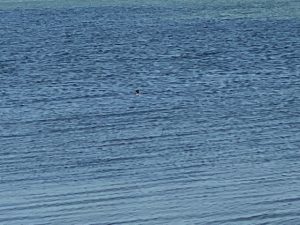
It may be hard to see, but there was a small duck enjoying the Sound.
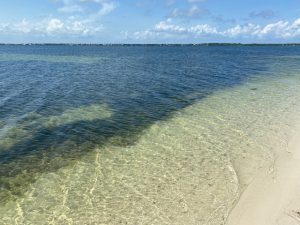
With little rain over the last few days the water clarity was excellent and you could see the seagrass very well.
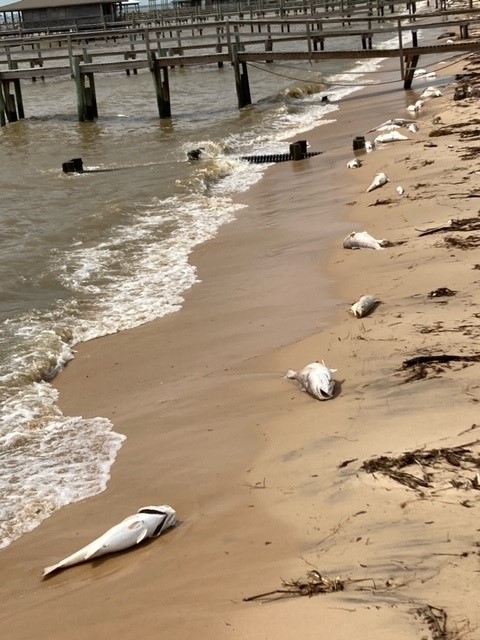
by Rick O'Connor | Apr 21, 2022
This began with a call from one of my volunteers who was checking salinity at Shoreline Park. She reported the salinity, but also reported to smell of dead fish – though she could not see them. I visited Shoreline Park the following day on another project and could smell it as well. There was a large amount of dead seagrass washed ashore from a recent storm and I thought this may be the cause of the smell because I did not see the dead fish either.
When I got home, I checked the FWC fish kill database. It reported a redfish kill in Pensacola Bay. It is unusual to see a kill of only one species. Many times, these are releases from fishing activity, particularly bait, and thought this must be the case – FWC did not mention the cause. I let the volunteer know and asked to keep an eye out.
I reported this to the Escambia County Division of Marine Resources to (a) let them know, and (b) to find out if they had any idea of cause. They replied that the location was incorrect. The kill was actually near Galvez Landing on Innerarity Point. He (Robert Turpin) had visited the site and did find any dead fish. I have a lot of volunteers over that way so asked each to take a look. They did not see any dead fish. I asked them to keep an eye out and collect a dead fish if they saw one for testing. Often when a large fish kill occurs, and it is only one species, the suspect cause is disease. Tissue samples could confirm this.
And then came another call.
This time it was from one of our Master Naturalist who lives on the eastern shore of Mobile Bay. He wanted to know what was up with all of the dead redfish along the shore of the bay. He sent photos and his beach was littered with them. I reached out to Mississippi/Alabama Sea Grant to see if they knew what was going on. They had heard about the situation and knew the Alabama Department of Natural Resources was collecting samples. The Gulf Islands National Seashore then reported large numbers of dead redfish along the National Shores property in Mississippi, something was up.

Dead redfish on the eastern shore of Mobile Bay.
Photo: Jimbo Meador
I eventually got word from Dr. Marcus Drymon at the Dauphin Island Sea Lab. They had a team working on this. Their team reported that stratification of the Gulf had created a hypoxic (low dissolved oxygen) layer on the bottom and the male “bull redfish” had gathered for breeding and died.
So, we are back to our title – what is stratification and how did this cause the fish kill?
Stratification is the layering of the water. Less dense water will sit atop the more dense. Water temperature or salinity can cause this density difference and layering. Colder and/or saltier water is denser and will form the bottom layer. If you have high winds, it will mix the water and the stratification disappears. Tides and currents can affect this as well.
What they believe happened recently was excessive amounts of rainfall created a large layer of freshwater to move from Mobile Bay into the open Gulf. The combination of tides and wind allowed a stratified layer to form. The oxygen that marine life uses is dissolved into the water at the surface and referred to as dissolved oxygen (DO). If the system is stratified, then the oxygen dissolved at the surface will not reach the bottom and hypoxia (low DO) can happen. They this is what happen. It just so happens that the large male redfish (bull reds) had congregated just offshore for breeding. They are more sensitive to low DO than the smaller females and any juveniles. So, the males died. To answer the question as to why other fish did not die (what you typically see in a DO related fish kill) – the numbers were not mentioned by there was one reference to 4.0 ppm. This is the high threshold of hypoxia. Many fish can tolerate at this concentration, but the male redfish could not.
So, that is what we think happened. The perfect storm of the demise of a group of male redfish just off of Mobile, and the carcasses drifted to other locations.

by Rick O'Connor | Apr 21, 2022
It is now spring, and wildlife is beginning to stir more. However, on this April day another cold front had just past the area and the morning temperature was 59°F. To add to this, there was a strong west wind that made it feel colder. Despite the fact it was an early spring morning in Florida, I had my fleece on and was dubious that I would see any reptiles.
This month’s hike was out at Big Sabine near Park East. The Gulf of Mexico was churning like a washing machine due to the passing front and the beach had a sharp scarp to it. There were a few plovers out trying to probe the sand for food, but not much else. Usually after hard winds you will find an assortment of things washed up on the beach but there was little really, possibly removed by the storm. There were however signs of digging by humans. It is now sea turtle nesting season, and we remind folks that these large holes can be a real problem for the mothers trying to nest. Please fill them in before you leave the beach.
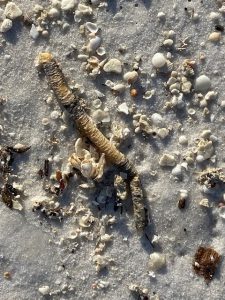
Diopatra are segmented worms similar to earthworms who build tubes to live in. These tubes are often found washed up on the beach.
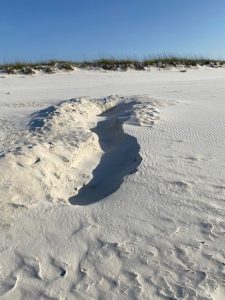
Large holes like this can be problematic for many island wildlife species – like nesting sea turtles. Please fill them in when you leave for the day.
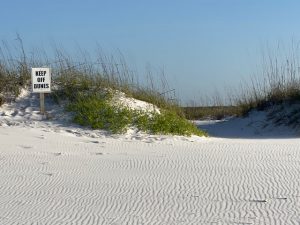
“Blow outs” are formed by people walking over the dunes. They will increase the erosion of these dunes and enhance flooding during storms. Please cross over on boardwalks.
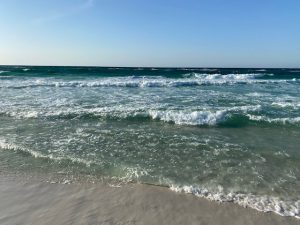
The Gulf of Mexico was churned up due to the passing cold front.
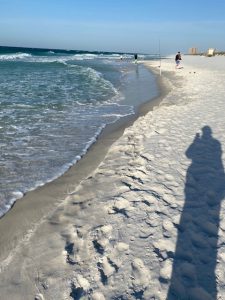
Beach scarps are formed during heavy surf changing the dynamics of the beach for creatures living there.
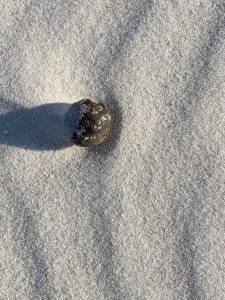
“Sea Beans” are seeds of tropical plants that wash ashore this time of year. Most do not germinate and those that do are usually on a high energy beach and do not survive.
As you head north into the dune fields the wind typically slows, but this morning it was blowing plenty hard, and I was getting “sand blasted” at some points. Not the best day to find wildlife. The sun was out and I decided to check the leeward side of shrubs and bushes, but had no luck.
One thing I did find was the sandhill milkweed in bloom. This plant is host to the monarch butterfly caterpillars and produces a mildly toxic “milk” which the caterpillars accumulate making them toxic to birds. This toxin is carried on to the adult butterfly stage and many birds learn to avoid butterflies with the monarch coloration because of the bad taste. Though I saw lots of milkweed, it was too windy for the butterflies.
The blooms of the false rosemary, which appear in late winter, had all fallen but it was obvious that the pine trees had release their pollen. Most of the scrubby pines in the dunes had new growth on them.
There were several ephemeral ponds scattered amongst the dunes. All had water in them from the recent rains and I was hoping to maybe find a basking snake or singing frog. No luck on either. There were damp areas where water had recently been, and the carnivorous sundews and spore producing club moss, known as ground pines, were doing very well.
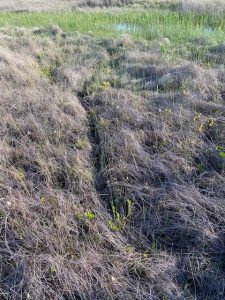
The path used by wildlife to reach the ponds of the dune field.
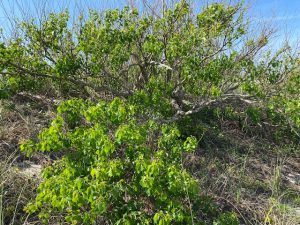
Two invasive Chinese tallow trees were found growing in the dune field. These will be removed.
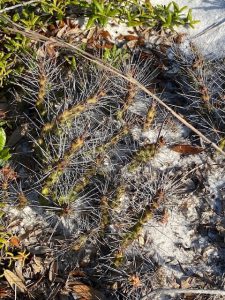
Devil’s Joint is a common cactus in the dunes. Wear shoes when exploring!
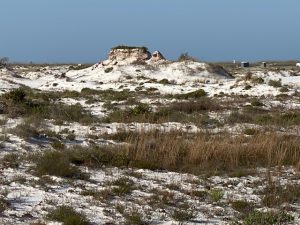
The high winds of the beach can form some interesting dunes. This one resembles the mesa’s of the American southwest.
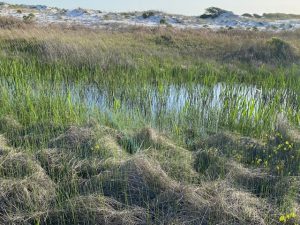
There are numerous freshwater ponds in the low areas of the dune field. Many of them are ephemeral.
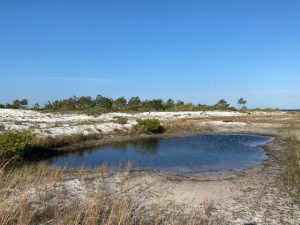
Freshwater ephemeral pond.
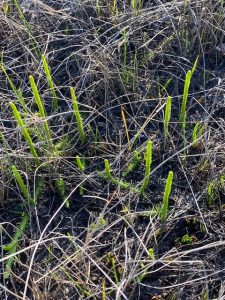
Ground pine is a type of club moss found in the wet-damp areas of the dunes.
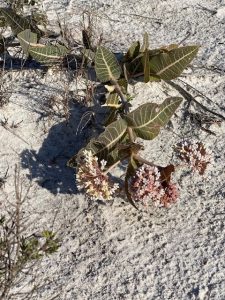
The sandhill milkweed is bloom this time of year.
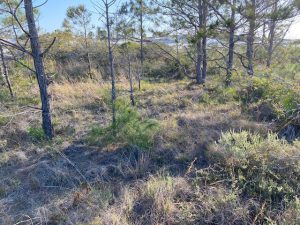
Pine scrub areas like this are found in the dune fields and are great places to find snakes and lizards.
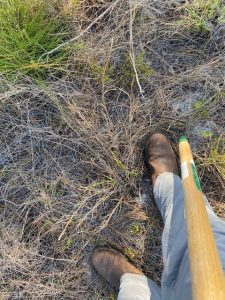
Since some of our snakes are venomous, it is recommended you wear good boots and have a hiking stick to move logs and high grass before stepping in or over.
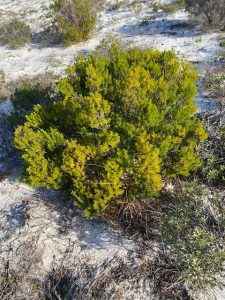
Seaside rosemary produces a wonderful smell that reminds many of the beach.
As I moved from the dunes into the maritime forest, I was expecting to see birds. I did, but not many. Most were small woodland birds I could not identify, and there was an osprey flying over briefly, but for the most part the bird action was slow today – again, probably due to the high winds. I was again hoping to maybe find a basking snake on the sunny leeward side of a bush or fallen tree but had none. I did find a common parasitic plant that was becoming more common this time of year. It is called “love-vine” or dodder. This yellow-colored string looking vine lacks chlorophyll and wraps around host plants to remove much needed nutrients. It begins to appear this time of year and is not restricted to the beaches. I have seen it 10 miles inland.
One thing that was very evident in the maritime forest was sign of armadillos. Their tracks and digs were found everywhere. I did locate a few burrows and found even more along the beach of the Sound. These animals are very abundant on this island I am curious as to what predators they have and how their populations are controlled. They can be found day or night and dig frequently looking for grubs and other invertebrates to eat. Whether they seek out turtle or bird eggs I do not know. More on this guy next month.
I will add that I did see tracks of raccoons who do eat turtle eggs and also what I think was a “slide” of an otter. The number of otter encounters has increased in recent years. Individuals have been seen not only on the beach but around Bayou Texar and Project Greenshores. These are very elusive animals and produce a high pitched “chirp” or “bark” when approached. I have seen them near Ft. Pickens on a couple of occasions in the ponds. There are the old hatchery ponds at Big Sabine, and it was there that I found the “slide”. These slides are used by the otters to slide into the water. I have seen video of them exiting the water, sliding back in, only to repeat this as if they were playing like kids – and I think that is what they are doing… playing. Otters are the largest members of the weasel family, mustelids, and pretty cool.
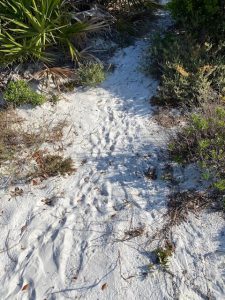
Many creatures use the same trails we do. This is a good place to look for tracks.
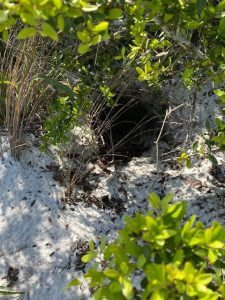
Armadillos are all over the island. This is a burrow of one.
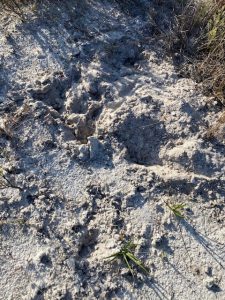
The digging of armadillos can be found everywhere as well.
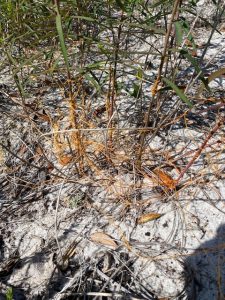
Dodder (or “love vine”) is a parasitic plant that begins to appear this time of year.
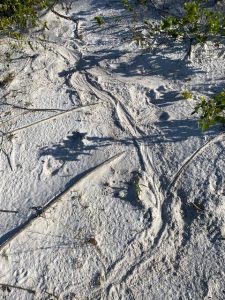
This is what I think to be an otter slide. Though I could not find tracks to confirm, I have seen them build and use these before.
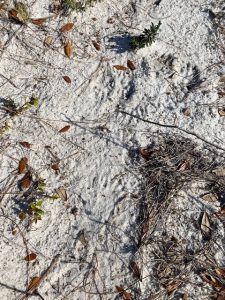
Raccoons are common all over the island.
The marsh of Big Sabine was pretty quiet on this windy day. I did see two Canadian geese walking along the shore. I recently saw several nesting on an island in Okaloosa County and was told they were now year-round residents. I am not sure whether these were residents to Big Sabine or not, I had not seen them before, but will note this as this series continues this year.
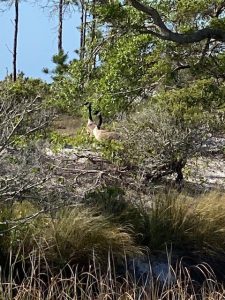
Canadian geese are becoming residents on some islands along the panhandle.
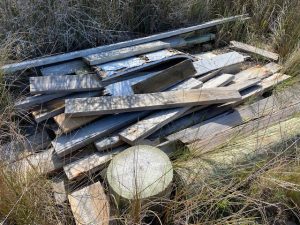
Wood piles like these can be good habitat for some beach wildlife.
The beach of Santa Rosa Sound was quiet as well. Again, I probed around to seeking a basking snake, a nesting terrapin, or maybe a nesting horseshoe crab (it was a spring tide day) but found nothing. There are piles of wood gathered by locals cleaning the beach and these actually make good habitat for some wildlife. I poked around in them but did not find anyone today. This was also where I found most of the armadillo burrows. Why they preferred this over the forested areas I am not sure. There may be many more in the forest that I just did not see. The spring tide was rising and much of the beach was exposed but I saw no fiddler crabs or other creatures and there was nothing swimming nearshore in the grass beds. Again, the lower temperatures and high winds I am sure had everyone in a warmer calmer place.
Despite little wildlife today it was a great walk and despite the high winds, the weather was actually nice. It is spring and nesting should be going on across the island. We will visit Ft. Pickens in May and see what is going on then.
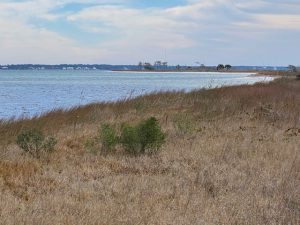
Santa Rosa Sound.
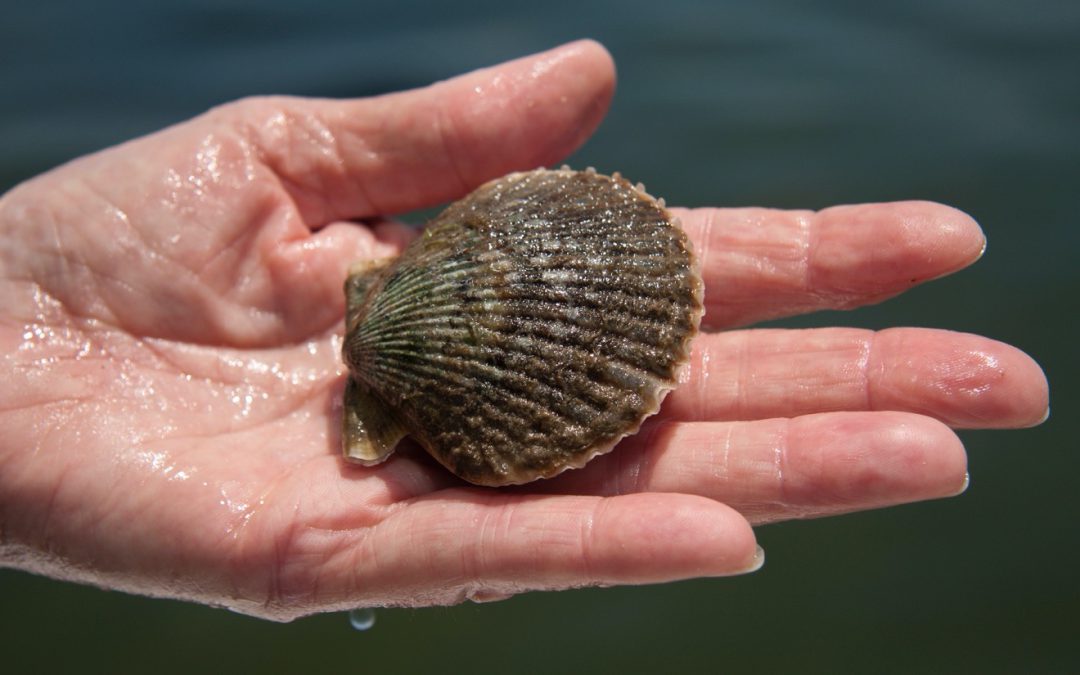
by Ray Bodrey | Apr 1, 2022
Special to the Panama City News Herald
L. Scott Jackson
UF/IFAS Extension Bay County / Florida Sea Grant
Ray Bodrey
UF/IFAS Extension Gulf County / Florida Sea Grant
Do you live in Bay, Gulf, and Franklin County? We need your help! Scallop Sitters is one of our cooperative volunteer programs with Florida Fish and Wildlife (FWC).
Historically, populations of bay scallops were in large numbers and able to support fisheries across many North Florida bays, including St Andrew Bay, St Joe Bay, and Alligator Harbor (Franklin County). Consecutive years of poor environmental conditions, habitat loss, and general “bad luck” resulted in poor annual production and caused the scallop fishery to close. Bay scallops are a short-lived species growing from babies to spawning adults and dying in about a year. Scallop populations can recover quickly when growing conditions are good and can decline dramatically when growing conditions are bad.
An opportunity to jump start restoration of North Florida’s bay scallops came in 2011. Using funding from the Deepwater Horizon Oil Spill, a multi-county scallop restoration program was proposed and eventually set up in 2016. Scientists with FWC use hatchery reared scallops obtained from parents or broodstock from local bays to grow them in mass to increase the number of spawning adults near critical seagrass habitat.
FWC also created another program where volunteers can help with restoration called “Scallop Sitters” in 2018 and invited UF/IFAS Extension to help manage the volunteer part of the program in 2019 which led to targeted efforts in Gulf and Bay Counties.
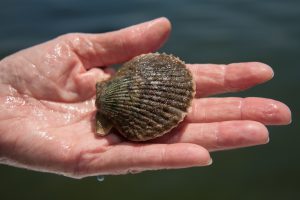
Giving scallops a helping hand, “Scallop Sitters” work with UF/IFAS Extension, Florida Sea Grant, and FWC restoration scientists by cleaning scallops and checking salinity once a month from June through January. Photo by Tyler Jones, UF/IFAS Extension and Florida Sea Grant.
After the 2020 hiatus due to COVID-19, the program boasted nearly 100 volunteers for the 2021 campaign. UF/IFAS Extension is once again partnering with FWC in Bay and Gulf and Franklin Counties. Despite challenges with rainfall, stormwater runoff, and low salinity, our Scallop Sitter volunteers have supplied valuable information to researchers and restoration efforts, especially in these beginning years of our program. Scallop Sitters collect useful information about salinities throughout the target bays. But the bulk of the impact comes with keeping a close watch on their scallops. The scallops maintained by their sitters have a better chance of a successful spawn when the time is right.
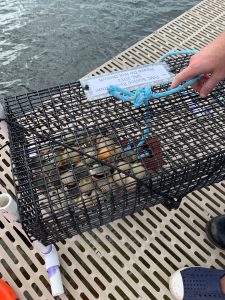
A “Scallop Sitter” cage ready for placement near seagrasses. The cages are restoration tools used to produce baby scallops during the annual growing cycle. Photo by L. Scott Jackson.
So, what does a Scallop Sitter do? Volunteers manage predator exclusion cages of scallops, which are either placed in the bay or by a dock. The cages supply a safe environment for the scallops to live and reproduce, and in turn repopulate the bays. Volunteers make monthly visits from June until January to their assigned cages where they clean scallops removing attached barnacles and other potential problem organisms. Scallop Sitters watch the mortality rate and collect salinity data which helps figure out restoration goals and success in targeted areas.
You are invited! Become a Scallop Sitter
- Register
Franklin County https://bit.ly/franklinscallopsitter22
Gulf County https://bit.ly/gulfscallopsitter22
Bay County https://bit.ly/bayscallopsitter22
- You will be sent a registration survey via email, a virtual workshop link, and an invite to our Northwest Florida Scallop Sitter Facebook Group.
- View a virtual workshop or you can attend our Kickoff Reception 9:30 AM before picking up your scallops and supplies. See the pick-up schedule below.
- Pick-up supplies and scallops:
Franklin County: June 2nd Kickoff Reception 9:30AM, Pick-up 10:00AM – 1:00 PM (Eastern)
Gulf County: June 9th Kickoff Reception 9:30AM, Pick-up 10:00AM – 1:00 PM (Eastern)
Bay County: June 16th Kickoff Reception 9:30AM, Pick-up 10:00AM – 1:00 PM (Central)
An Equal Opportunity Institution. UF/IFAS Extension, University of Florida, Institute of Food and Agricultural Sciences, Andra Johnson, Dean for UF/IFAS Extension. Single copies of UF/IFAS Extension publications (excluding 4-H and youth publications) are available free to Florida residents from county UF/IFAS Extension offices.
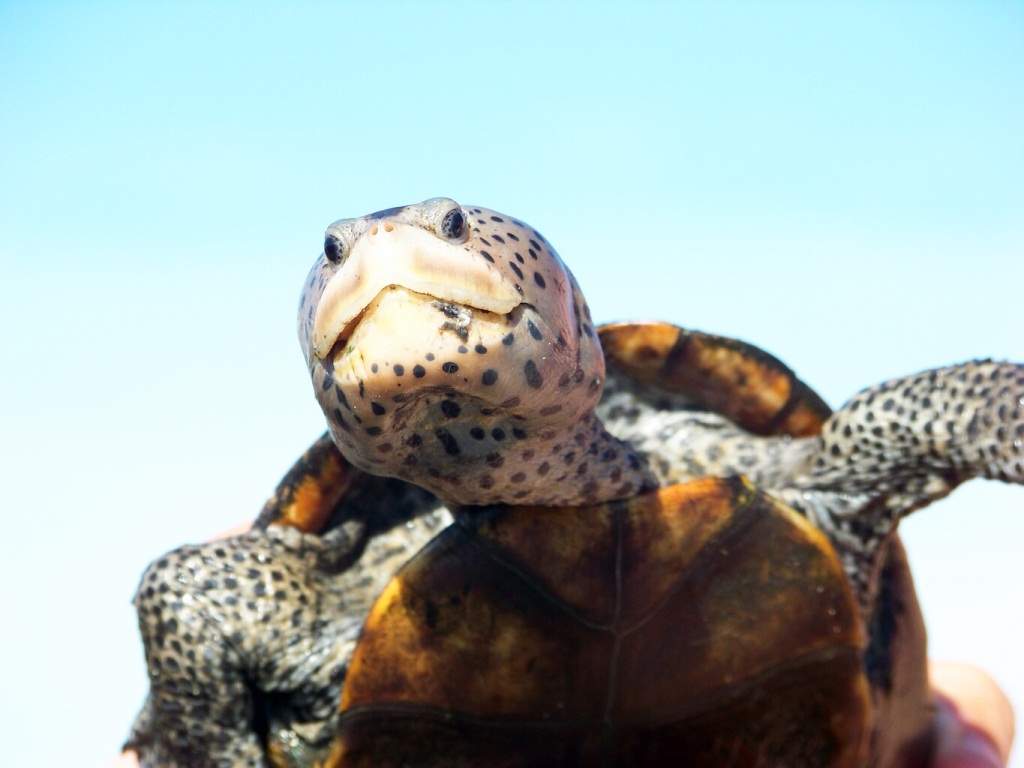
by Rick O'Connor | Mar 11, 2022
Let’s begin by stating what a diamondback terrapin is. I have found many Floridians are not familiar with the animal. It is a turtle. A turtle in the family Emydidae which includes the pond turtles, such as cooters and sliders. The big difference between terrapins and the other emydid turtles is their preference for salt water. They are not marine turtles but rather estuarine – they like brackish water.
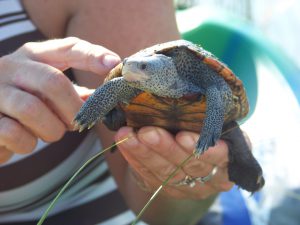
The diamond in the marsh. The diamondback terrapin.
Photo: Molly O’Connor
Their haunt are the salt marshes and mangroves of the state. Their range extends from Massachusetts down the east coast and covering all of the Gulf of Mexico over to Brownsville Texas. There are seven subspecies of the animal within that range. Five of those live in Florida and three only live in Florida. They are more abundant, and well known, in the Chesapeake Bay area where they are the mascot of the University of Maryland. In Florida they seem to be more secretive and hidden. Encounters with them are rare and there has been concern about their status for years. Though researchers are not 100% sure on their population size, it was felt that more conservation measures were needed.
Ten years ago, the issue with all turtles in the state was the illegal harvest for the food trade. All sorts of species were being captured and sent to markets overseas. The Florida Fish and Wildlife Conservation Commission (FWC) stepped in and set possession quotas on many species of Florida turtles. For terrapins, the number was two. For some, like the Suwannee Cooter, there was a no possession rule.
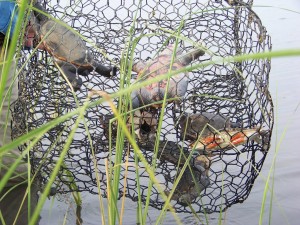
Drowned terrapins in a derelict crab trap in the Florida panhandle. (photo: Molly O’Connor)
There has also been concern with incidental capture of terrapins in crab traps. These turtles have been known to swim into the traps and drown. In the Chesapeake Bay area, they have found as many as 40 dead turtles in one trap. Not only is this bad for the turtles, but it is also bad for the crab fisherman because high numbers of dead turtles in the trap means no crabs. Studies began to develop some sort of excluder device that would keep terrapins out, but allow crabs in. Dr. Roger Wood developed a rectangle shaped wire excluder now called a By-Catch Reduction Device (BRD) that reduced the terrapin capture by 80-90% but had no significant effect on the crab catch. That was what they were looking for. This BRD has been required on crab traps up there for years.
What about Florida?
Studies using the BRD were also conducted here with the same results, but the BRD was not required. Incidental capture in crab traps does occur here but not to the extent it was happening in the Chesapeake and FWC wanted to hold off for more science before enacting the rule. BRDs were available for those who wanted them, but not required. This past December (2021) that changed.
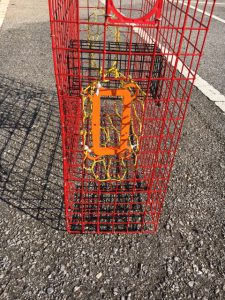
This orange plastic rectangle is a Bycatch Reduction Device (BRD) used to keep terrapins out of crab traps – but not crabs.
Photo: Rick O’Connor
In recent years there has been another issue with harvesting terrapins for the pet trade. With this, and other conservation concerns for this turtle, FWC developed a new rule for terrapins at their December 2021 meeting.
- The possession limit for terrapins has dropped from 2 to 0 – there is a no-take rule for this animal beginning March 1, 2022. Collection for scientific research will still be allowed with a valid collecting permit from the FWC. Those who currently have two or less terrapins in their possession as pets may keep them but must obtain a no cost personal possession permit to do so by May 31, 2022. Those who have terrapins within an education center may keep them but must obtain a no cost exhibit permit by May 31, 2022.
- Recreational crab traps will require the BRD device by March 1, 2023. You have a year. Those in the Pensacola area can contact me for these. I have a case of them I am willing to provide to the public.
Again, studies have shown that these BRDs do not significantly impact the crab catch. Crabs can turn sideways and still enter the traps. But reducing incidental capture of terrapins will hopefully increase their numbers in our state. For information on how to obtain the needed permits visit FWC.
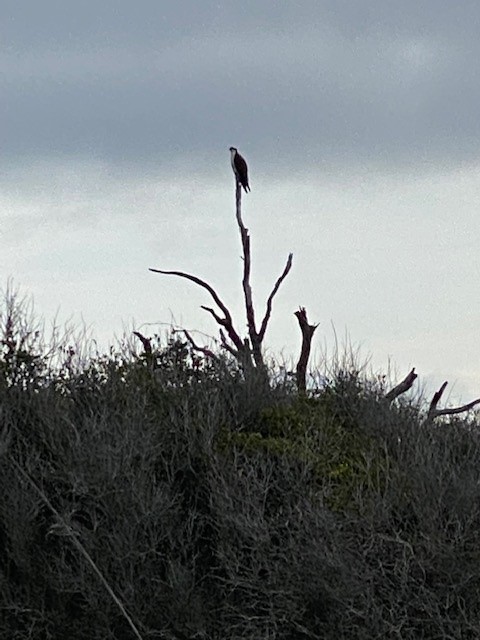
by Rick O'Connor | Mar 11, 2022
The month of March is the last of winter. For todays hike we returned to Gulf Islands National Seashore/Ft. Pickens where it was 63°F, overcast with a strong breeze from the northwest. A cold front is coming through to remind us that winter is not over yet. It was not 44°F as it was on our February hike but with the wind and cloud cover, it was a bit cool and not ideal for most wildlife to be out. But the ospreys were…
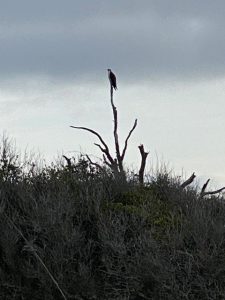
Osprey perched.
Photo: Rick O’Connor

An osprey pair building a nest on the chimney of the ranger station at Ft. Pickens.
Photo: Rick O’Connor
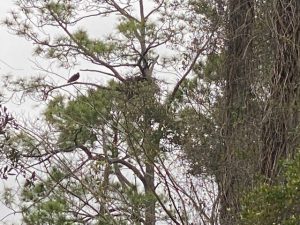
Another osprey pair with a nest in a large pine.
Photo: Rick O’Connor
They were everywhere. Building nests in live pines, dead snags, platforms built just for this, and on the chimney of the ranger station. Their sounds were everywhere – it is breeding season for them. The great blue herons were still nesting, we saw them first in January, but there are still a few around. American egrets were out as were numerous mourning doves. As with the colder February day, it was primarily bird action right now. I did see evidence of armadillos, and would guess other mammals were on the move, but did not see evidence of any others. The reptiles and amphibians are still missing – but should not be for long.
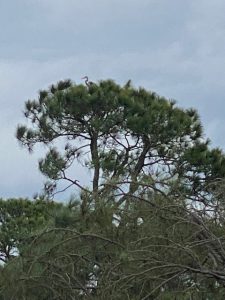
The herons began nesting in January. Some are still there.
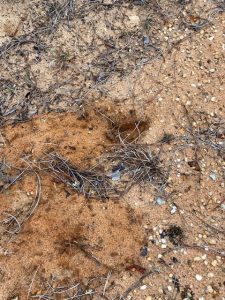
Evidence of armadillos digging.
The plant I know as beach heather, many call false rosemary, and has the scientific name Conradina, was in full bloom. After the hollies of the Christmas season, these are the plants I often see bloom first. Though I have seen bees around my home already, and wasps, I did not see/hear any insect movement this morning.
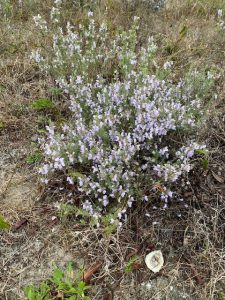
Beach heather (false rosemary) is one of the first plants to bloom on our islands.
The north beach (Pensacola Bay) was rough due to the northwest wind. It was difficult to see if anything was moving around in the shallows. There were a lot of shells on the shore. Two particularly caught my eye. The Florida Fighting Conch was pretty abundant, more than normal – and there were several scallops shells. There are two species locally, the calico scallop (often found in the Gulf) and the bay scallop (the estuarine version and the one of “scalloping” fame). Calcio scallops are often pinkish in color and often with spots. The bay scallop is usually gray in color. Those I saw this morning were all bleached white but, based on other variety of shells in the mix, I am thinking these were calcio scallops.
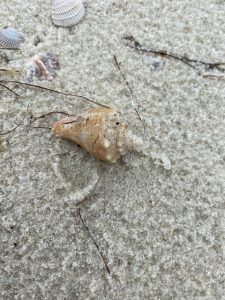
There were several Florida Fighting Conch shells on the beach this month.
There was very little marine debris today and no tracks of any kind seen. There was only one lone pelican spotted, maybe due to the high winds they settled somewhere else. Maybe they have moved off to smaller islands for breeding themselves, I am not sure.
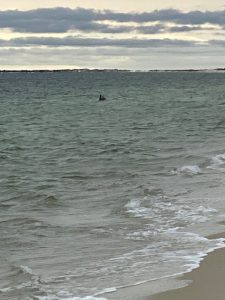
We only saw this one lone pelican today.
Though the wildlife has been more restricted to birds at the moment, the birding is excellent right now and the beach has relatively few people – it is a great time to take a hike out there.
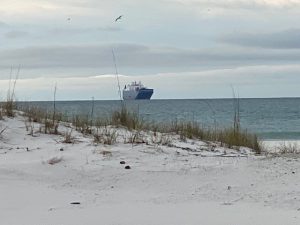
This large tanker awaits its turn to enter Pensacola Bay.
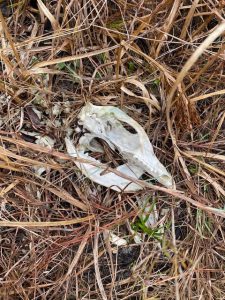
This skull found along the side of the side of the road is believed to be a raccoon.
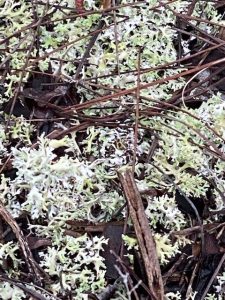
Lichen is an organism that is a partnership between algae and fungus. They were a brilliant white-green this month.
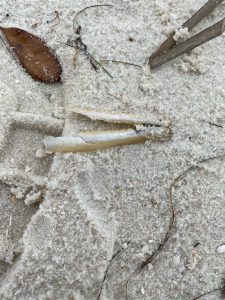
Razor clam shells are quite common along the shoreline.
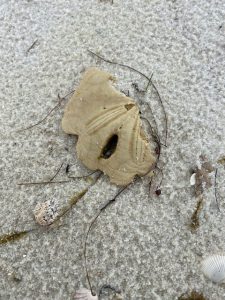
Sand dollars are not as common on the bay side of the island but there were several today.
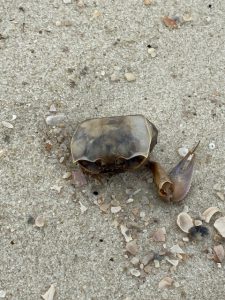
The remains of a ghost crab.
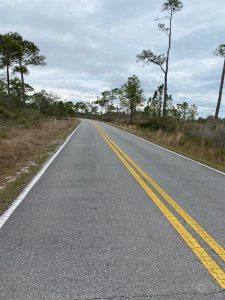
Believe it or not, walking along the road is a great spot to find wildlife.








































































